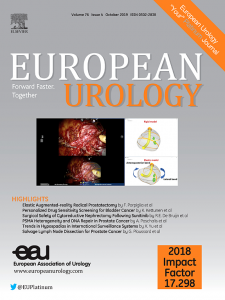机器人经膀胱膀胱颈重建:一种治疗膀胱尿道吻合口狭窄的新方法
IF 25.3
1区 医学
Q1 UROLOGY & NEPHROLOGY
引用次数: 0
摘要
背景与目的我们的目的是研究一种新型机器人经膀胱入路膀胱颈重建术在膀胱输尿管吻合口狭窄(VUAS)手术治疗中的效果。方法:我们对我们的单机构机器人膀胱颈部重建术数据库进行回顾性分析,以确定所有在2021年至2024年期间连续接受机器人经膀胱膀胱颈部重建术(RTV-BNR)以最终治疗VUAS的患者。该手术技术包括沿周切除纤维化瘢痕组织,并通过后膀胱入路在膀胱颈部粘膜和后尿道之间建立一个粘膜-粘膜、水密、无张力的吻合口。主要结果是手术成功,定义为患者在初始手术后不需要任何额外的手术再干预复发性狭窄。次要结局包括新发应激性尿失禁(SUI)和主要(Clavien级>;2)术后并发症。主要发现和局限性11例患者符合纳入标准。2例(18%)患者在RTV-BNR前有补救性放疗史。所有狭窄长度均为2cm。手术时间中位数为189 min(四分位数间距[IQR] 122-248),估计失血量中位数为100 ml (IQR 50-100)。所有患者均无新发SUI。中位随访22个月(IQR 14-30), 10例患者(91%)手术成功。该研究的主要局限性是其回顾性,样本量小,缺乏与已建立的VUAS管理技术结果的直接比较。结论:srtv - bnr是一种安全有效的治疗VUAS的创新技术。本文章由计算机程序翻译,如有差异,请以英文原文为准。
Robotic Transvesical Bladder Neck Reconstruction: A Novel Approach to Managing Vesicourethral Anastomotic Stenosis
Background and objective
Our aim was to investigate outcomes of a novel robotic transvesical approach for bladder neck reconstruction in the surgical management of vesicourethral anastomotic stenosis (VUAS).Methods
We performed a retrospective review of our single-institution database of robotic bladder neck reconstruction procedures to identify all consecutive patients who underwent robotic transvesical bladder neck reconstruction (RTV-BNR) for definitive management of VUAS between 2021 and 2024. The surgical technique involves circumferential excision of fibrotic scar tissue and creation of a mucosa-to-mucosa, watertight, tension-free anastomosis between the bladder neck mucosa and posterior urethra via a posterior transvesical approach. The primary outcome was surgical success, defined as patients who did not require any additional surgical reintervention for recurrent stenosis after the initial procedure. Secondary outcomes included de novo stress urinary incontinence (SUI) and major (Clavien grade >2) postoperative complications.Key findings and limitations
Eleven patients met the inclusion criteria. Two patients (18%) had a history of salvage radiotherapy before RTV-BNR. All strictures were <2 cm in length. The median operative time was 189 min (interquartile range [IQR] 122–248) and median estimated blood loss was 100 ml (IQR 50–100). None of the patients developed de novo SUI. At median follow-up of 22 mo (IQR 14–30), the surgery was successful in ten patients (91%). Major limitations of the study are its retrospective nature, small sample size, and lack of a direct comparison to outcomes with established techniques for VUAS management.Conclusions and clinical implications
RTV-BNR is an innovative technique that may offer a safe and effective approach for VUAS management.求助全文
通过发布文献求助,成功后即可免费获取论文全文。
去求助
来源期刊

European urology
医学-泌尿学与肾脏学
CiteScore
43.00
自引率
2.60%
发文量
1753
审稿时长
23 days
期刊介绍:
European Urology is a peer-reviewed journal that publishes original articles and reviews on a broad spectrum of urological issues. Covering topics such as oncology, impotence, infertility, pediatrics, lithiasis and endourology, the journal also highlights recent advances in techniques, instrumentation, surgery, and pediatric urology. This comprehensive approach provides readers with an in-depth guide to international developments in urology.
 求助内容:
求助内容: 应助结果提醒方式:
应助结果提醒方式:


